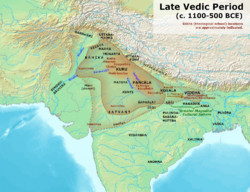Philosophy:Ancient Mithila University
प्राचीन मिथिला विश्वविद्यालय | |
| Location | Mithila region of Bihar and Nepal |
|---|---|
| Region | Mithila |
| Part of | Ancient Universities in Indian Subcontinent |
| History | |
| Cultures | Hinduism |
Ancient Mithila University refers to the tradition of Brahminical study in the Mithila region.[1][2] From the 12th/13th to 15th century CE it was an important centre of Nyaya Shastra and logical sciences.[3][1]
Arrival of Vedic culture

During the late Vedic times, Mithila was a "frontier region" of Brahmanism,[6] and the adjacent Magadha region belonged to the cultural sphere of greater Magadha, were Indo-Aryans were present but with a culture which differed from the Vedic culture of Kuru-Panchala.[4] The Vedic culture, and it's tradition of Brahmanical learning reached Videha, in the Mithila region, at the end of the Vedic times at ca. 700 BCE. In the Ramayana, Mithila is the native land of Sita, the wife of the hero Rama.[7] According to the Ramayana, the court of her fgather, a king Janaka, attracted scholars and philosophers.[8]
The White Yajurveda, which contains the Brihadaranyaka Upanishad, was composed in this area.[7] The Brihadaranyaka Upanishad narrates the presence of learned Brahmins from Kuru-Panchala, the center of Vedic culture, at the court of a king Janaka of Viheda to perform a sacrifice, questioning the local sage Yajnavalkya, but unable to defeat him.[9][10] Yajnavalkya explains the concept of Atman to the learned Brahmins, and the concept of karma, driven by desire, is first introduced here in Indian philosophical-religious texts.[11]
Mithila school of logic
Late medieaval Eastern schools of Brahmans were focused on Nyaya Shastra and logical sciences, in contrast to the Vedanta of southern Brahmins from the Vijayanagara cultural area.[3] According to Vidyabhusana, the science of logic developed out of parishad, councils of learned Brahmins.[12] The Mithila school of Nyaya was an Indian school of Nyaya philosophy, which flourished from the 12th-13th to the 15th century in Mithila.[13][14] Students were not allowed to take any piece of written information with them after finishing their studies, to keep a monopoly on this subject.
See also
- Vedic learning in Mithila
References
- ↑ 1.0 1.1 Scharfe (2002), p. 189–191.
- ↑ Vidyabhusana (1988).
- ↑ 3.0 3.1 Bronkhorst, Diaconescu & Kulkarni 2013, p. 98.
- ↑ 4.0 4.1 Bronkhorst (2007).
- ↑ Samuel 2010.
- ↑ Olivelle 1998, p. xxxvii-xxxix.
- ↑ 7.0 7.1 Glucklich (2008), p. 60.
- ↑ Chaudhury (1964), p. 566-568.
- ↑ Dalal (2014), p. "Janaka".
- ↑ Glucklich (2008), p. 60 ff.
- ↑ Glucklich (2008), p. 63-64.
- ↑ Vidyabhusana (1920), p. 22.
- ↑ Sharma & Sharma (1996), p. 20.
- ↑ Chaudhury (1964), p. 567.
Sources
- Bronkhorst, Johannes (2007). Greater Magadha: Studies in the Culture of Early India. BRILL. ISBN 9789004157194.
- Bronkhorst, Johannes; Diaconescu, Bogdan; Kulkarni, Malhar (2013), "The Arrival of Navya-Nyaya Techniques in Varanasi", An Indian Ending. Rediscovering the Grandeur of Indian Heritage for a Sustainable Future. Essays in Honour of Professor Dr. John Vattanky SJ On Completing Eighty Years, Delhi: Serial Publishers
- Chaudhury, P.C. Roy (1964), ihar District Gazetteers: Darbhanga, Superintendent Secretariat Press, http://www.indianculture.gov.in/bihar-district-gazetteers-darbhanga
- Dalal, Roshen (2014), Hinduism: An Alphabetical Guide, Penguin Books
- Glucklich, Ariel (2008), The Strides of Vishnu: Hindu Culture in Historical Perspective, Oxford University Press
- Olivelle, Patrick (1998). The Early Upanisads. Oxford University Press. ISBN 978-0195124354.
- Samuel, Geoffrey (2010), The Origins of Yoga and Tantra. Indic Religions to the Thirteenth Century, Cambridge University Press
- Scharfe, Hartmut (2002). "Chapter 10" (in English). Education in Ancient India. 16th. Netherlands: Brill. pp. 189–191. ISBN 90-04-12556-6. https://library.mibckerala.org/lms_frame/eBook/Scharfe%20-%20Education%20in%20Ancient%20India%20(Brill).pdf.
- Sharma, Ram Nath; Sharma, Rajendra Kumar (1996), History of Education in India
- Singh (2021). "A HISTORICAL STUDY OF LIBRARIES OF MEDIEVAL INDIA". International Journal of Scientific & Innovative Research Studies 9. https://www.csirs.org.in/uploads/paper_pdf/a-historical-study-of-libraries-of-medieval-india.pdf.
- Vidyabhusana, Mahamahopadhyaya Satis Chandra (1920) (in English). A History of Indian Logic (Ancient, Mediaeval and Modern Schools). Library Genesis. Motilal Banarsidass. http://archive.org/details/historyindianlog00vidy.
- Vidyabhusana, Satis Chandra (1988) (in en). A History of Indian Logic: Ancient, Mediaeval and Modern Schools. Motilal Banarsidass Publishers. ISBN 978-81-208-0565-1. https://books.google.com/books?id=0lG85RD9YZoC&q=university+of+ancient+mithila.
